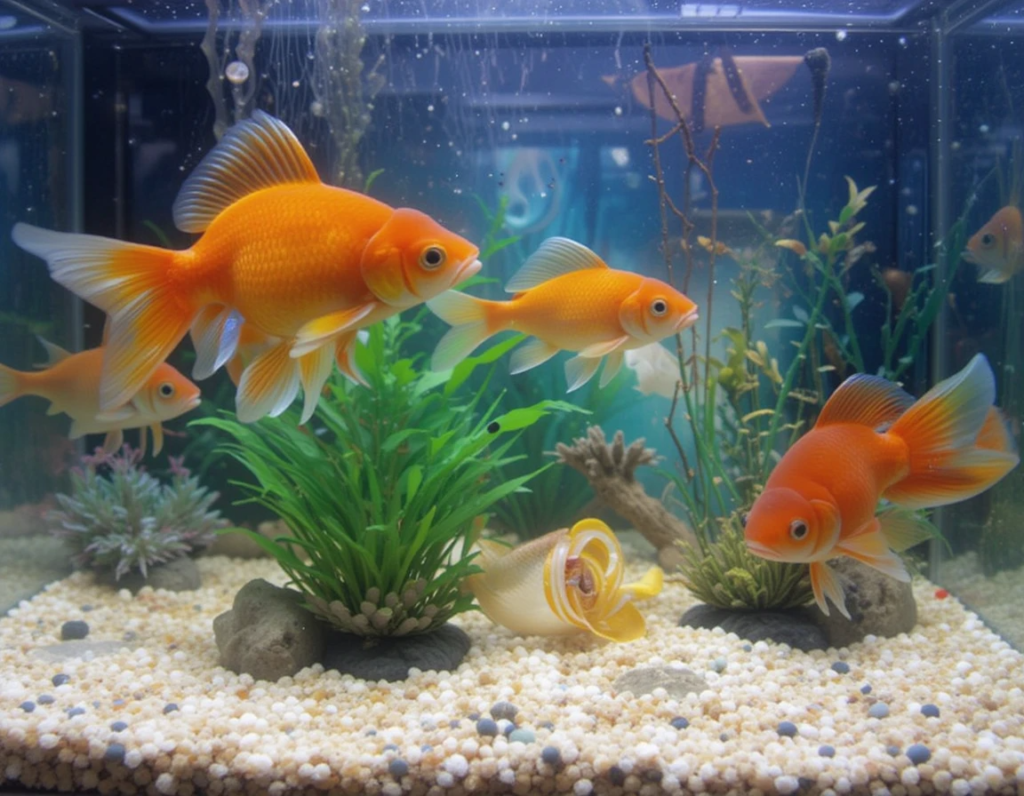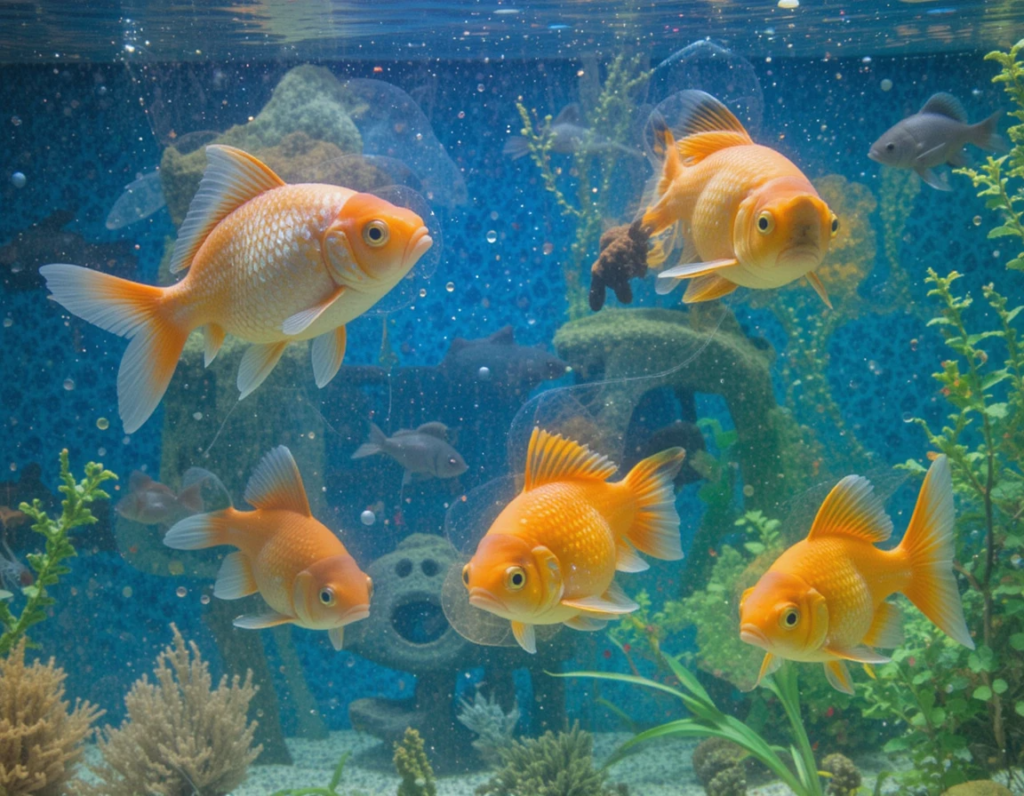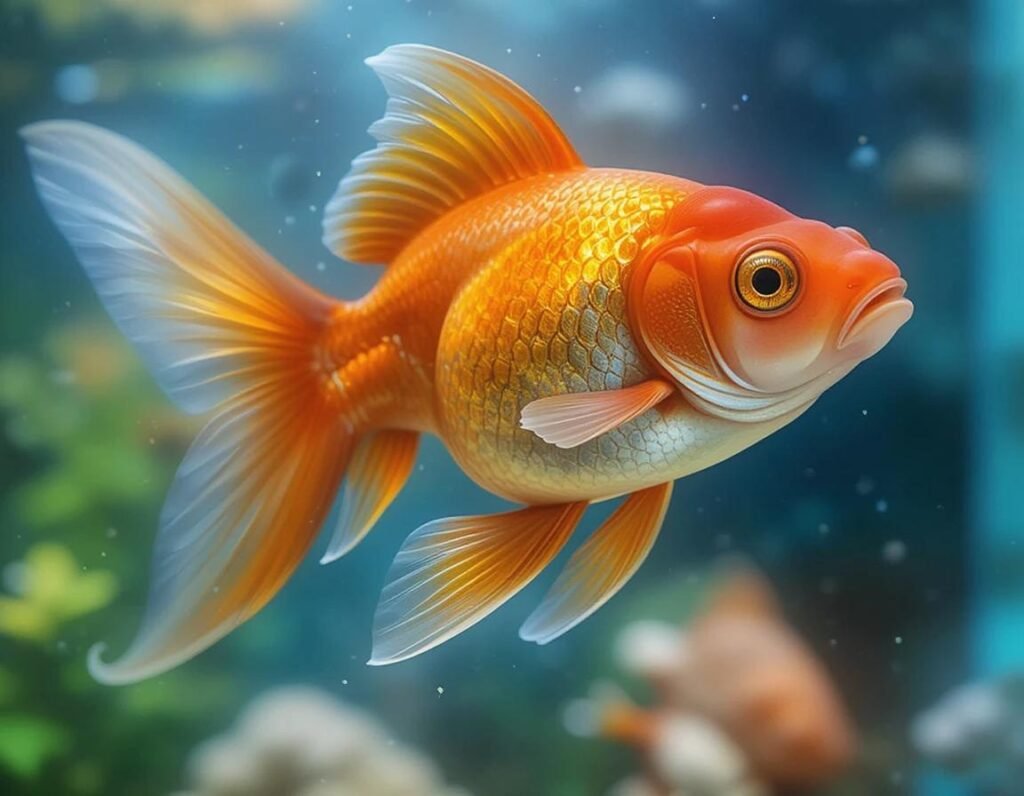
Goldfish Tank Maintenance: Keeping Your Finned Friend’s Home Sparkling!
If you’re a goldfish owner, you know how important it is to keep your fish’s home clean and healthy. After all, happy goldfish make for happy owners, right? Proper tank maintenance isn’t just about keeping things tidy—it’s about creating a safe and comfortable environment for your fishy friend to thrive in. So, let’s dive into the basics of goldfish tank maintenance and make sure your tank is the sparkling palace it deserves to be!
Why is Goldfish Tank Maintenance Important?
You might be wondering, “Why does my goldfish need such a fancy home?” Well, just like we need clean air, food, and a comfy bed, goldfish need clean water, proper filtration, and a safe environment. Maintaining a healthy tank helps prevent illness, ensures your goldfish grows to its full potential, and can even make your goldfish look more vibrant (who doesn’t love a good glow-up?). Regular maintenance also keeps the water free from harmful toxins and waste, which could stress out your goldfish.
1. Water Changes: A Goldfish’s Best Friend
Water changes are the cornerstone of goldfish tank maintenance. As your goldfish swims around, it produces waste (lots of it, trust us), and that waste can lead to a buildup of ammonia, nitrates, and nitrites. If left unchecked, these toxins can make your fishy friend sick or stressed. So, how often should you change the water? We recommend doing a 25-30% water change every 1-2 weeks.
Tip:
Don’t do a full water change all at once! Goldfish don’t love sudden changes, and doing so could stress them out. Keep it gradual, and remember, water changes are your best friend in keeping the tank clean and your fish happy.
2. Filter Maintenance: The Unsung Hero
Think of your filter as your goldfish’s personal air purifier. It helps keep the water clear and removes toxins, which makes it super important for tank health. Over time, the filter will collect debris and gunk, so it’s essential to clean or replace the filter media every month (depending on the type of filter you have).
Tip:
When cleaning your filter, use aquarium water (not tap water!) to avoid killing the beneficial bacteria that help break down waste in your tank. Your filter is like the brain of the tank—let’s keep it healthy!
3. Keep an Eye on Water Parameters: The Goldfish Spa Treatment
Goldfish aren’t very picky, but they do have specific water needs to thrive. You should regularly check the following parameters:
- pH level: Goldfish prefer a neutral to slightly alkaline pH (7.0-7.5).
- Ammonia and Nitrite levels: These should always be at 0. Elevated levels can cause health issues.
- Nitrate levels: Aim for less than 40 ppm (parts per million) to keep things safe.
- Temperature: Goldfish like cooler water—around 65°F to 72°F (18°C to 22°C).
Test your water with a reliable aquarium test kit at least once a week. This will help you catch any issues before they become a problem.
4. Gravel Vacuuming: It’s Like Spring Cleaning, But for Your Tank
Goldfish love to nibble on everything, including their food. This means they often leave little remnants of uneaten food at the bottom of the tank (and let’s be real, who doesn’t love a good snack?). While this might sound cute, it can also lead to water contamination. That’s where gravel vacuuming comes in! Once a week, gently vacuum the gravel to remove uneaten food, fish waste, and other debris.
Tip:
Don’t be afraid to get your hands dirty with a gravel vacuum. It’s kind of like giving your goldfish a spa day, and your tank will thank you for it.
5. Aquarium Decorations: Clean and Safe
Goldfish love to explore their tank, so it’s important to keep decorations in top shape. Over time, decorations can collect algae and dirt. You don’t have to do this every week, but give them a good scrub every month. Make sure your decorations are smooth and free of sharp edges to avoid injury to your goldfish.
Tip:
Add plants (real or artificial) for enrichment! Goldfish enjoy swimming around and hiding in plants, and they also help keep the water cleaner. Just be sure to regularly clean them to avoid algae buildup.
6. Feeding: Keep It Balanced, Not Overboard
Overfeeding is a common mistake among goldfish owners. Goldfish are bottomless pits, but feeding them too much can lead to water quality problems (and a bloated fish!). Feed your goldfish 2-3 times a day, only what they can eat in a few minutes. Remember, uneaten food is your tank’s enemy—so always remove it if they don’t finish it.
Tip:
Switch up their diet with some veggie snacks like peas or spinach for extra nutrients. Goldfish are like kids—they enjoy variety!
7. Monitor for Signs of Illness: Stay Vigilant!
Healthy goldfish are active, curious, and have clear, vibrant coloring. If you notice your goldfish looking sluggish, hiding more than usual, or showing changes in color or appearance, it could be a sign of stress or illness. Regular tank maintenance can prevent a lot of health problems, but you should also keep an eye on your goldfish’s behavior and overall well-being.
Tip:
When in doubt, don’t hesitate to consult with a vet who specializes in fish. Better safe than sorry!
8. Tank Size and Space: Bigger is Better
When it comes to tank size, goldfish are the true aristocrats of the aquarium world—they need space to stretch their fins! While it’s common to see goldfish in small tanks, this is far from ideal. A larger tank allows for better water quality, more swimming room, and an overall happier goldfish. A good rule of thumb is to provide at least 20 gallons of water for one goldfish, plus an extra 10 gallons for each additional fish.
Tip:
Goldfish are notorious for growing bigger than you expect, so upgrading their tank might become necessary as they grow. It’s like upgrading from a cozy studio apartment to a spacious penthouse. Your goldfish will thank you!
9. Dealing with Algae: A Green Thumb’s Dilemma
If you’re noticing green fuzz creeping up on your tank walls, it’s time to tackle algae. Algae can thrive in tanks that receive too much light, so controlling the amount of sunlight your tank gets is crucial. Keep the tank in a shaded area or use a tank cover to help control light exposure.
Tip:
Introduce some algae-eating snails or a few freshwater shrimp to help keep algae in check. They’ll munch away at the green stuff, leaving your tank looking pristine (and providing your goldfish with some interesting tankmates).
10. Temperature Control: No Goldfish Ice Skating!
Goldfish like it cool, not chilly! Keeping the water at the right temperature is essential for their health. If the water is too warm, it can reduce the oxygen levels, leading to stress. If it’s too cold, your goldfish might slow down, and their immune system could weaken. To keep things comfortable, maintain a steady water temperature between 65°F and 72°F (18°C to 22°C).
Tip:
If you live in an area where temperatures fluctuate wildly, invest in a reliable aquarium heater with a thermostat. Just make sure the water doesn’t go overboard on the heat—goldfish prefer a gentle, steady warmth, not a tropical vacation.
11. Monitor for Aggression and Stress: A Peaceful Goldfish is a Happy Goldfish
Goldfish are generally peaceful creatures, but if there’s too much competition for food or territory, they might get stressed or even aggressive. If you notice one goldfish bullying another or if a fish is hiding too much, it could be a sign that things are a bit too tense in the tank. Keeping the tank peaceful and well-stocked with hiding spots can prevent these issues.
Tip:
Don’t overcrowd your goldfish tank. Space out your goldfish buddies and create plenty of hiding spots with plants and decorations so they can avoid confrontations. Think of it as creating a peaceful community for your aquatic neighbors.
12. Regular Monitoring: Be the Lifeguard of Your Tank
While it’s important to do routine maintenance, you also need to check in on your tank regularly. Doing a quick visual inspection every day or so can help you spot any issues early, like water cloudiness, sick fish, or equipment malfunctioning. Trust us—being proactive will save you a lot of stress (and cleaning) down the road.
Tip:
Keep a log of your water tests, filter maintenance, and any tank changes. It’s like keeping a diary, but instead of writing about your day, you’re tracking your goldfish’s health. It’s a simple habit that can make a big difference!

Final Thoughts: Making Goldfish Tank Maintenance a Breeze
Goldfish care doesn’t have to be overwhelming—once you establish a regular maintenance routine, keeping your tank clean and your goldfish healthy will feel like second nature. Plus, as you watch your goldfish swim gracefully through the water, you’ll realize it’s all worth it. A clean tank is not only a great environment for your fish but a beautiful centerpiece for your home. So, keep up with those water changes, monitor your goldfish’s behavior, and enjoy your sparkling aquarium!
FAQs About Goldfish Tank Maintenance
1. How often should I clean my goldfish tank?
Answer: You should clean your goldfish tank regularly to ensure a healthy environment. Perform a 25-30% water change every 1-2 weeks. Additionally, clean the filter monthly and vacuum the gravel weekly to remove excess waste and debris.
2. Do I need a filter for my goldfish tank?
Answer: Yes! A filter is crucial for maintaining water quality in your goldfish tank. Goldfish produce a lot of waste, and a filter helps remove toxins like ammonia and nitrites. Make sure to clean or replace the filter media every month.
3. How do I know if the water quality in my tank is good?
Answer: You should regularly test the water using an aquarium test kit to check the pH, ammonia, nitrite, and nitrate levels. Goldfish prefer a neutral pH (7.0-7.5), and the levels of ammonia and nitrites should always be at 0. Nitrate levels should stay below 40 ppm for optimal health.
4. How can I prevent algae from growing in my goldfish tank?
Answer: Algae can grow if the tank gets too much light or if the water quality is poor. To prevent this, avoid placing your tank in direct sunlight and keep your lighting on a timer (about 8-10 hours a day). You can also introduce algae-eating snails or shrimp to help keep things clean.
5. How often should I feed my goldfish?
Answer: Goldfish should be fed 2-3 times a day, only giving them as much food as they can eat in a couple of minutes. Overfeeding can lead to excess waste in the tank, which can affect water quality. Remove any uneaten food after a few minutes.
6. Is it okay to use tap water for my goldfish tank?
Answer: Yes, but you’ll need to treat the tap water with a water conditioner to remove chlorine and chloramine, which are harmful to goldfish. Always let the water sit for a few hours and add the conditioner before putting it into the tank.
7. Why does my goldfish sometimes swim near the surface and gasp for air?
Answer: If your goldfish is gasping at the surface, it could be due to low oxygen levels in the water. This could happen if the tank is overcrowded, the filter is dirty, or the water temperature is too high. Ensure your tank has proper filtration and aeration, and monitor the temperature.
8. Can I add plants to my goldfish tank?
Answer: Yes, goldfish love plants! However, keep in mind that goldfish may nibble on live plants. Hardy plants like Java fern, anubias, and hornwort are great options. You can also use artificial plants to decorate, but make sure they are soft and free from sharp edges.
9. Do I need to clean the decorations in my goldfish tank?
Answer: Yes, aquarium decorations should be cleaned regularly to prevent algae buildup and debris accumulation. Remove decorations every couple of weeks and give them a scrub with aquarium-safe tools. Avoid using soap or chemicals, as these can harm your goldfish.
10. What signs should I watch for to know if my goldfish is stressed or unhealthy?
Answer: Signs of stress or illness in goldfish include clamped fins, erratic swimming, faded color, scratching against objects, or excessive hiding. If your goldfish is showing any of these symptoms, check the water quality and look for potential stressors in the environment. If the problem persists, consider consulting a vet who specializes in fish.
11. Can I do a full water change in my goldfish tank?
Answer: It’s not recommended to do a full water change all at once because it can shock your goldfish. Instead, aim to change 25-30% of the water regularly. A full water change should only be done if there’s a serious issue, like a chemical imbalance or a tank contamination.
12. How do I keep my goldfish tank clean without stressing my fish?
Answer: To keep your tank clean without causing stress, perform regular, smaller tasks. Vacuum the gravel to remove waste, clean the filter once a month, and do 25-30% water changes every 1-2 weeks. This gradual upkeep is less stressful than letting the tank go too long without attention.


